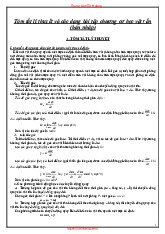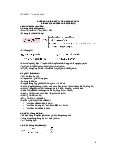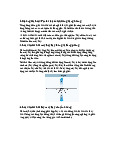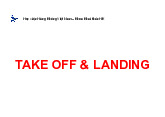











Preview text:
Ôn tập bài tập giữa kỳ cơ học và tính năng tàu bay Bài tập Turning Bài tập bay bằng W T = CL/CD Vstall = √ 2mg ρ x S x CLmax 1 1
VTAS = √ 2mg =√ 2mg x = VEAS x ρ x S x CL ρ0 x S x CL √σ √σ 1 1 L = 2
x ρ x V x S xCL = x ρ 2 2 0 x V2EASx S x CL 1 1 D = 2
x ρ x V x S xCD = x ρ0 x V2EASx S x CD 2 2 (T ( CD ) min) khi (Dmin) khi min CL C 2 D = Cd + kCL C Dmd = 2Cd CLmd = √Cd k
VEASmd = √ 2mg x( k )14 ρ0 x S Cd ( CD ) (Pmin) khi 3 min C L2 C 2 D = Cd + kCL C Dmp = 4Cd
CLmp = √3Cd = √3CLmd k VEASmd
VEASmp = √ 2mg x( k )14 = 1 ρ0 x S 3 Cd 3 4
Exercise 1: An airplane weighing 150000 N has a wing area of 210 m2, and thrust of engine is 65.4 kN.
At the altitude of 9 km (σ =0.38), its cruise speed is 170 m/s.
(a) What are the values of CL and C of the airplane? D
(b) If the maximum lift coefficient that the airplane can achieve when fluing at the altitude of 9 km is
1.85, determine the "stall" speed of the airplane. W = 150000 N S = 210 m2 T = 65400 N σ =0.38 Veas = 170 m/s a/ CL ? CD ? L = W = mg = 150000
ρ = ρ0 x σ = 1.225 x 0.38 = 0,4655 1 2 L 2 x 150000 L = 2 x ρ x V x S xC = = 0.106 2 L CL = 2 2 ρ x V x S 0.4655 x 170 210 x T = D = 65400 N 1 2 D 2 x 65400 D = 2
x ρ x V x S xCD CD = = = 0.046 2 2 2 ρ x V x S 0.4655 x 170 210 x b/ CLmax = 1.85; Vstalll ?
Vstall = √ 2mg = √ 2x150000 = 40,72 m/s ρ x S x CLmax
0.4655 x 210 x 1.85
Exercise 2: The Messerschmidt 109 was produced in huge quantities during World War 2 and was a
very able and dependable aircraft. Over 35,000 were produced between 1936 and 1945. The M109
has a wing area of 16m2 and a mass of 3000 kg.
(a) At a height of 6000 m, where ρ = 0.55ρ0 the M109 has a cruise speed of V =160m/s. Calculate the
corresponding lift coefficient, CL.
(b) If CLmax = 2.9, calculate the airspeed at stall at sea level. S = 16m2 m = 3000 kg
a/ ρ = 0.55 ρ0 = 0.55 x 1.225 = 0.67375; Veas =160m/s; C ? L
L = W = mg = 3000 x 9,8 = 29400 1 2 L 2 x 29400 L = 2 x ρ x V x S xC = = 0.213 2 L CL = 2 2 ρ x V x S 0.67375 x 160 16 x
b/ CLmax = 2.9; Vstall at sea level ? Vstall at sea level = √ 2 mg
= √ 2x29400 = 32.16 m/s ρ0 x S x CLmax 1.225 x 16 2.9 x
Exercise 3: A Spitfire aircraft has wing area of 22.48 m2, a mass of 3000 kg and a cruise speed of V =
139 m/s at an altitude of 4570 m, where the air density ρ ≈ 0.7 kg/m3.
(a) Calculate the lift coefficient at the cruising speed.
(b) The stall speed is 32.6 m/s at sea level. Calculate CL,max at stall and also calculate the stall speed at 4570m S = 22.48 m2 M = 3000 kg Veas = 139 m/s ρ ≈ 0.7 kg/m3 a/ C ? L
L = W = mg = 3000 x 9,8 = 29400 N 1 2 L 2 x 29400 L = 2 x ρ x V x S xC = = 0.1933 2 L CL = 2 2 ρ x V x S 0.7 x 139 22.48 x
b/ Vstall at sea level = 32.6 m/s; CLmax at stall ? Vstall, 4570m ? 2 mg 2 x 29400 Vstall at sea level = √ 2 mg CLmax at stall = = = 2.009 2 2 ρ0 x S x CLmax ρ 0 x S x V 1.225 22.48 x x 32.6
Vstall, 4570m = √ 2mg = √ 2x29400 = 43.12 m/s ρ x S x CLmax
0.7 x 22.48 x 2.009
Exercise 4: An airplane weighing 50000 kg has a wing area of 210 m2, and thrust of engine is 23.4 kN.
At the altitude of 5.5 km (σ =0.75), its cruise speed is 100 m/s.
(a) What are the values of CL and C of the airplane? D
(b) Determine the stall speed of the airplane at this height if CLmax = 1.42 m = 50000 kg S = 210 m2 T = 23400 N σ =0.75 Veas =100 m/s a/ CL ? CD ?
L = W = mg = 50000 x 9.8 = 490000 N
ρ = ρ0 x σ = 1.225 x 0.75 = 0.91875 1 2 L 2 x 490000 L = 2 x ρ x V x S xC = = 0.5079 2 L CL = 2 2 ρ x V x S 0.91875 x 100 210 x T = D = 23400 N 1 2 D 2 x 23400 D = 2
x ρ x V x S xCD CD = = = 0.02425 2 2 2 ρ x V x S 0.91875 x 100 210 x b/ CLmax = 1.42; Vstalll ?
Vstall = √ 2mg = √ 2x490000 = 59.8 m/s (cái này sai đáp số so với slide) ρ x S x CLmax
0.91875 x 210 x 1.42
Exercise 6: An aircraft weighs 56,000 lbs and has a 900 ft2 wing area. Its drag polar is given by: CD = 0.01575 + 0.03334 CL2.
(a)Find the minimum thrust required for cruising flight and the corresponding airspeeds at sea-level
(true air speed) and at 30,000 ft (0.000889 slugs/ft³)
(b) Find the minimum power required and the corresponding true airspeeds for cruising flight at sea- level and at 30,000 ft W = 56000 lbs S = 900 ft2
CD = 0.01575 + 0.03334 CL2 Cd = 0.01575; k = 0.03334
a/ Tmin ? VEAS at sea level ? Vmd, 30000ft ? (T )
min) khi (Dmin) khi ( CD min CL
CDmd = 2Cd = 2 x 0.01575 = 0.0315
CLmd = √Cd = √0.01575 = 0.687 k 0.03334 0.687 CLmd /CDmd = = 21.80 0.0315 W 56000 Tmin = = = 2568.80 N CLmd /CDmd 21.8
ρ0= 1.225 kg/m3 = 1.225 x 0.00194 = 0.002377 slugs/ft3.
VEAS at sea level = √ 2mg = √ 2 x 56000 = 276.054 ft/s ρ0 x S x CL
0.002377 x 900 x 0.687
ρ30,000= 0.458 kg/m³ = 0.000889 slugs/ft³ 0.000889
σ = ρ0 x ρ30,000 = = 0.374 0.002377 1 1
Vmd, 30000ft = VTAS = VEAS x = 276.054 x = 451.39 ft/s √ σ √0.374
b/ Pmin ? VEASmp ? Vmp, 30000ft ? C 2 D = Cd + kCL C
Dmp = 4Cd = 4 x 0.01575 = 0.063
CLmp = √3Cd =√3x0.01575 = 1.188 k 0.03334 0.063 (P ) min) khi ( CD3 min = 3 = 0.048 C L2 1.1882
VEASmp = √ 2mg x( k )14 = √ 2x56000 x( 0.03334 )14 = 209.7 ft/s ρ0 x S 3 Cd 0.002377 x 900 3 x 0.01575 1 1
VEASmp, 30000ft = VTAS, 30000ft = VEAS x = 209.7 x = 342.9 ft/s √ σ √0.374
Pmin = Tmin x VEASmp = 2568.80 x 209.7 = 538677.36 ft-lb/s
Pmin, 30000ft = Tmin x VEASmp, 30000ft = 2568.80 x 342.9 = 880841.52 ft-lb/s
Exercise 7: An aircraft has a mass of 14000 kg and a wing area of 18 m2, sải cánh =13.41 m, its drag
polar is given by: C =0.015+ 1.2*CL2/(πAR). Find; D
(a) Equivalent airspeeds if the thrust of the engine at mean sea level is 11000 N..
(b) CD,CL at minimum drag flight condition
(c) CD,CL at minimum power flight condition m = 14000 kg S = 18 m2 Wingspan, =13.41 𝑏 T = 11,000 N C 2 D=0.015+ 1.2*CL /(πAR) 2 2 13.41 AR = b = =9.99 S 18 Cd = 0.015; k = 0.038 a/ Veas ?
L = W = mg = 14000 x 9.8 = 137200 N T = D = 11000 N 1 2 D 2 x 11000 D = 2
x ρ 0 x Veas x S x C = (1) 2 D CD = 2 2 ρ 0 x V x S 1.225 x Veas x 18 2 L 2 x 137200 CL = = 2 2 ρ 0 x V x S 1.225 x Veas x 18 Ta có: 2 C C L 2 D = 0.015 +1.2 x = 0.015 0.038 +
x CL = 0.015 + 0.038 x ( 2 x137200 )2(2) πAR 2 1.225 x Veas x 18 Từ (1) và (2) ta có: 2 x 11000
=0.015+0.038 x ( 2x137200 )2 2 2 1.225 x Veas x 18 1.225 x Veas x 18 Veas = 80.988 m/s b/ CDmd,CLmd ? C 2 D = Cd + kCL C
Dmd = 2Cd = 2 x 0.015 = 0.03
CLmd = √Cd = √0.015 = 0.628 k 0.038 c/ CDmp,CLmp ? C 2 D = Cd + kCL C
Dmp = 4Cd = 4 x 0.01 5 = 0.06
CLmp = √3Cd =√3x0.015 = 1.08 k 0.038



